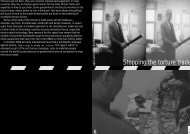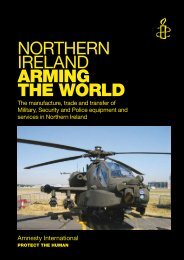CROWD CONTROL TECHNOLOGIES - Omega Research Foundation
CROWD CONTROL TECHNOLOGIES - Omega Research Foundation
CROWD CONTROL TECHNOLOGIES - Omega Research Foundation
Create successful ePaper yourself
Turn your PDF publications into a flip-book with our unique Google optimized e-Paper software.
3.2 The International Committee Of The Red Crosss (ICRC) SIrUS Project. The ICRC is already<br />
beginning to explore the extent to which their SIrUS Project ("Superficial Injury or Unnecessary<br />
Suffering") can be applied to specific effects caused by 'less-lethal weapons'. Their concern regarding<br />
superfluous injury and unnecessary suffering relates to design-dependent effects of specific weapons<br />
on health. 62 Based on considerable experience, ICRCs view is that conventional weapons are not<br />
necessarily fatal. Their statistics gathered as part of the SIrUS project indicate that the proportion of<br />
wounded who die in the field from injuries inflicted by so called lethal weapons is less than 25%, 60% of<br />
those wounded by conventional weapons suffer no )permanent injury( and go on to complete physical<br />
recovery. Such findings underline the fact that so called non-lethal weapons cannot be considered as<br />
a separate unique category of weapons but rather according to ICRC as new weapons coming within<br />
the scope of the existing laws of war. Whilst any non lethal weapons need to be measured against the<br />
norms and principles of international humanitarian law particularly before they can be used in United<br />
Nation mandated operations, it has to be recognised in this context that much of international<br />
humanitarian law is only applicable to armed conflicts where war has been declared. 63<br />
3.3 International Human Rights Law & Crowd Control Weapons Of The Future. The development<br />
of certain types of weapons such as radio frequency, acoustic or directed energy weapons like the<br />
plasma gun, depends on a knowledge of patho-physiological or psychological effects. A victim may not<br />
even be aware that an attack is taking place or be able to surrender and, if wounded, may not be able<br />
to seek medical assistance. Unlike other restrictions on weapons created in biomedical laboratories<br />
such as chemical and biological weapons, no specific international treaty yet applies. However, some<br />
of these weapons present the risk of permanent disability or long lived post traumatic stress syndrome<br />
(PTSS) which will require specialised treatment. For example those subject to electro-shock torture with<br />
stun batons or targeted by sticky foam and left adhered to the ground all day under a tropical sun, are<br />
likely to suffer some PTSS requiring specialist treatment if that person is to be fully rehabilitated and not<br />
suffer flashbacks. In the light of continued development of non lethal weapons, ICRC are proposing<br />
64 65<br />
amendments to the SIrUS proposals.<br />
3.4 International Legal Prohibitions Against Torture & Blinding Systems. The practice of torture is<br />
already covered by the Code of Conduct for Law enforcement Officials, adopted by the UN in 1979;<br />
Article 5 of the Universal Declaration of Human Rights; Article 7 of the Convention of Civil and Political<br />
Rights; Article 3 of Human Rights European Convention and the principles of medical ethics adopted<br />
by the UN General Assembly in 1982. More specifically torture is banned by the Convention Against<br />
Torture and Other Cruel, Inhumane or Degrading Treatment or Punishment (12 th April 1949); and the<br />
1997 European Convention for the Prevention of Torture and Inhuman or Degrading Treatment or<br />
Punishment. This report submits that the use of torture weaponry is also covered by 'The Certain<br />
Conventional Weapons Convention (Inhumane Weapons Convention) of 1980. Some crowd control<br />
technologies are also covered by the provisions of international legislation which encompasses their<br />
modus operandi. For example, the Blinding Laser Weapon Ban of 1995 has implications for future UV<br />
tetanizing lasers which can induce electroshock in human muscle tissue at a distance.<br />
3.5 Limits Imposed by Provisions of the Chemical Weapons Convention (CWC). Careful<br />
interpretation of this international legislation is required to determine the extent to which it<br />
encompasses current and future crowd control weapons. For example, the Biological Weapons<br />
Convention of 1972 applies to weapons which use plant toxins to create dispersal effects and the<br />
Chemical Weapons Convention of 1993, (updating and extending the Geneva Protocols of 1925) has<br />
implications for mass use of calmative drugs or rocket delivered pre-encapsulated chemical<br />
immobilising agents. 66 Within the CWC, riot agents are classified as toxic chemicals, falling under the<br />
general purpose criterion. 67 Although the CWC makes specific exceptions which allow the usage of<br />
chemicals for law enforcement purposes, the treaty does not define exactly what is meant by 'law<br />
enforcement'. 68 This issue becomes particularly vexed in relation to so-called peacekeeping<br />
operations, where the line between law enforcement and use as a method of warfare can become<br />
blurred should UN troops be deployed between hostile factions. This has happened in recent times,<br />
for example on 28 August 1997 the NATO SFOR contingent had to evacuate part of its International<br />
Police Task Forces from the Bosnian Serb town of Brcko. After clashes erupted between civilians and<br />
NATO peacekeeping forces, US helicopters dropped teargas and soldiers fired warning shots to effect<br />
xviii




